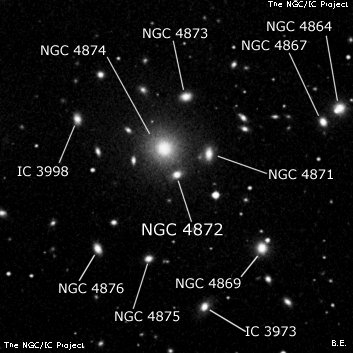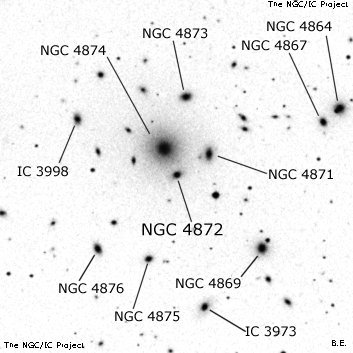NGC/IC Project Restoration Effort
(This is a very very beta version)
NGC4872


Basic Information
Location and Magnitude
Right Ascension: 12:59:35.8
Declination: +27:57:34
Constellation: COM
Visual Magnitude: 11.7
Historic Information
Discoverer: Herschel W.
Year of discovery: 1785
Discovery aperture: 18.7
Observational
Summary description: pF, pS, R
Sub-type: E0
Corwin's Notes
=====
NGC 4872. As seen above (NGC 4864), d'A's position for NGC 4872 is not much
different from that for NGC 4874. However, it may be one of three nebulae
that he noted around NGC 4874 on 5 May 1864, the only one of those three that
he attempted to measure. His comment about it is
"Not difficult to see; one of three similar. I compared previous measures
of the nebulae with this where I could; this is undoubtedly new."
The description suggests that this is one of N4874's satellites not seen by
the Herschels, yet Dreyer apparently not only adopted its position as that for
the brighter galaxy, but he also put all the Hershel numbers on it as well.
Unfortunately, d'A's position for this galaxy FOLLOWS NGC 4874 by four seconds
of time -- where there is nothing on the sky -- while the NGC position for
4872 PRECEDES NGC 4874 by the same amount. Dreyer, trying to reconcile all
the observations in the core of the cluster, put all the information about the
second-brightest galaxy in the core on the number 4872. Also, the position he
assigned to 4872 falls far enough west of the bright galaxy itself that the
number has been attached to one of the small "satellites" of the big
elliptical. While d'A's description tells us that he apparently measured one
of the three brighter satellite objects around NGC 4874, it does not tell us
which of the galaxies it is (it could well be NGC 4871 or NGC 4873), so
Dreyer's assignment was a partially-informed guess -- just as ours today must
be.
Let's step back for a moment and look at all of d'A's observations in the core
of the Coma Cluster. His positions precessed to J2000 for the Coma core
galaxies are on the first line (followed by the number of nights he observed
the galaxy and the WH and JH numbers that d'A assigned, if any; and any
applicable notes), the precessed NGC positions are on the second line, my
preferred modern positions are on the third line, followed by the differences
with d'A's positions, in the sense "modern minus d'A":
NGC RA Dec N d'A's idents Notes
H h
DelRA DelDec
seconds arcsec
4864 12 59 11.3 +27 58 50 3 --- 1500?
12 59 13 +27 58.6
12 59 13.26 +27 58 35.2 +2.0 -15
4865 12 59 14.9 +28 05 08 1 --- ---
12 59 15 +28 05.1
12 59 19.88 +28 05 03.4 +5.0 -5
4869 12 59 23.0 +27 54 49 6 II 388? 1501?
12 59 23 +27 54.8
12 59 23.37 +27 54 41.6 +0.4 -7
4872? 12 59 38.9 +27 57 33 1 --- --- Perhaps NGC 4871 or 4873?
12 59 35 +27 57.6 d'A's position is well east
12 59 34.11 +27 56 48.5 -4.8 -45 of NGC 4874, though.
4874 12 59 33.6 +27 57 30 7 II 389? 1502?
12 59 39 +27 57.5
12 59 35.70 +27 57 33.2 +2.1 +3
4881 12 59 56.0 +28 14 46 3 --- ---
12 59 56 +28 14.7
12 59 57.75 +28 14 47.9 +1.8 +2
4882 12 59 57.7 +27 58 40 1 --- --- = NGC 4886
12 59 58 +27 58.6
13 00 04.46 +27 59 15.3 +6.8 +35
4884 13 00 00.7 +27 58 22 1 --- --- = NGC 4889
13 00 01 +27 58.4
13 00 08.11 +27 58 36.9 +7.4 +15
4886 13 00 03.7 +27 58 46 2 --- ---
13 00 04 +27 58.8
13 00 04.46 +27 59 15.3 +0.8 +29
4889 13 00 08.7 +27 58 38 7 II 391 1507
13 00 08 +27 58.7
13 00 08.11 +27 58 36.9 -0.6 -1
4895 13 00 15.6 +28 12 09 3 --- ---
13 00 15 +28 12.2
13 00 17.92 +28 12 08.4 +2.3 -1
4898 13 00 18.6 +27 57 29 3 --- 1510?
13 00 18 +27 56.7
13 00 17.89 +27 57 21.2 -0.7 -8
Mean +2.48 +4.2 "NGC 4872?" not included.
Std Dev +-2.64 +-15.0
Notice that Dreyer has swapped d'A's RAs for "NGC 4872?" and 4874, but has
(except for NGC 4864 and 4898) adopted d'A's positions for these objects.
It's also worth mentioning again that "NGC 4872?" is outstanding in this list
with its RA being well EAST of the modern position, while all but two of the
other objects have their RAs WEST of the modern positions.
Here's another table, one containing just the data for the galaxies that d'A
measured on 5 May 1864.
NGC RA (J2000) Dec DelRA DelDec Notes
(modern - d'A)
seconds arcmin
4869 12 59 24 +27 54.5 -0.6 +0.2
4872? 12 59 39 +27 57.6 -4.9 -0.8 Pos is east of N4874
4874 12 59 35 +27 57.5 +0.7 +0.1
4886 13 00 4 +27 58.7 +0.5 +0.6
4889 13 00 9 +27 58.8 -0.9 -0.2 One of these two observations must
4889 13 00 10 +27 58.6 -1.9 0 be from another night.
4895 13 00 16 +28 12.4 +1.9 -0.3
4898 13 00 19 +27 58.0 -1.1 -0.6
Mean -0.20 -0.03 N4872? not included in mean
Std Dev +-1.20 +-0.36
It's easy to see here, too, that the observation that led to the NGC number
"4872" is anomalous.
Looking at the data, it's clear that we can't easily determine which of the
three galaxies around NGC 4874 d'A was looking at from either his position or
his description. As I noted above, it could as well be NGC 4871 or NGC 4873
-- or some other object -- as NGC 4872.
Bigourdan was also initially confused by the nomenclature in the NGC. In his
observations of NGC 4874, he comments "On avait cru mesurer 4872 N.G.C."
(roughly translated, "I thought I was measuring NGC 4872."). Similarly, under
his single observation of NGC 4872, he notes "On avait cru mesurer 4874 N.G.C."
However, sometime before he published his big table with the 12-13 hour data,
he corrected most of the numbers to agree with those being generally used
today. One he missed was in the description to an unpublished "nova" that he
found on the night of 17 May 1885. There, he notes "The nebula GC 3347 (NGC
4872) is at p(osition angle) = 10 [deg], d[istance] = 0' 42 [arcsec]." We
know now, of course, that GC 3347 is NGC 4874, not 4872, and that Bigourdan's
"nova" is NGC 4872 itself.
Dreyer, however, did not have these observations available when he was putting
together the NGC. He did what he could with data from the Herschels and d'A,
but that was not quite enough to accurately represent the core of the Coma
Cluster.
So, to avoid confusion with the current astronomical literature, I'm simply
going to keep the number "4872" on the galaxy "traditionally" known as NGC
4872 -- but now with a question mark.
See NGC 4864 for more about the core of the Coma Cluster, particularly the
Herschels' observations there.
Steve's Notes
=====
NGC 4872
18" (4/20/12): this is the closest of the swarm of small galaxies surrounding NGC 4874, situated just 48" SSW of center at the edge of the halo. At 322x it appeared similar to NGC 4871 (1.1' NW); faint, very small, round, 12"-15" diameter, very small brighter nucleus.
17.5" (4/21/90): this is the closest companion of NGC 4874 just off the SW edge of NGC 4874 in the core of AGC 1656. Very faint, very small, irregularly round, small bright core. A mag 12 star lies 1.3' SW. Located just 52" SW of the center of NGC 4874. A swarm of galaxies in the field with NGC 4871 1.1' NW, NGC 4873 2.2' N and NGC 4875 2.5' SSE.



